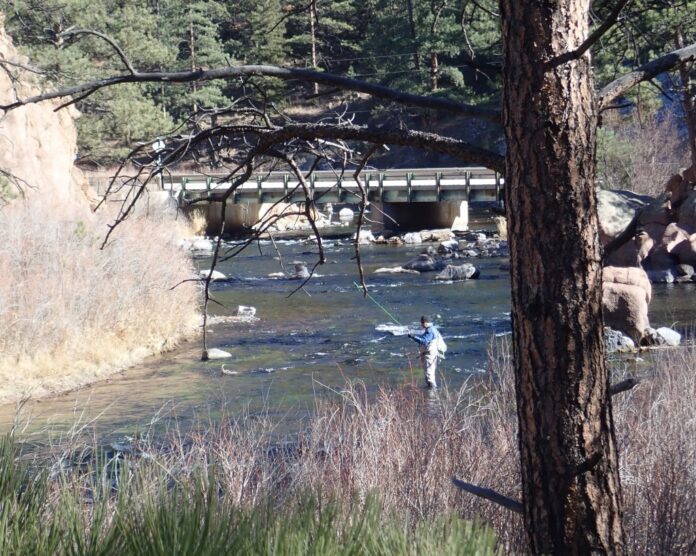On the first warm, cloudless, windless day after the mid-November cold snap, I headed to the South Platte River. It was a spur of the moment trip, but I knew that after the intensity of the cold snap I’d fish the Deckers section of the river. It’s the banana belt of the three South Platte River tailwaters, and I wanted to be as warm as you can be wading and fishing a river toward the end of November.
Before I could leave, I had to pick through my fishing gear that was scattered all over my spare room. I quickly pieced together an outfit that included fly boxes filled with nymphs, dry flies and emergers in small to very small hook sizes; fly floatant, 6X tippet material and fly reels. To that I added my 9-foot, 5-weight “soft” graphite fly rod. A rod that flexes more fully protects the light tippets you must use when you fish small flies. I also included my 10-foot euro-nymphing rod, but I’d already pretty much decided I’d use my 5-weight rod to high-stick nymphs with a strike indicator.
I put the smaller “stuff” into my spare fly fishing vest. The fly reels went into a small pack with my wading staff, gloves, camera, hat, and sunscreen. I grabbed a small piece of left-over meatloaf from the refrigerator for lunch, filled a few water bottles and made a thermos of green tea. I was carrying a lot stuff, but that’s what happens when you leave in a hurry and want to make sure you didn’t forget anything.
When I got to Deckers, trucks and cars full of fly fishers were already pouring into the area. The one disadvantage to fishing there is that it’s half way between Denver and Colorado Springs and easily accessed. Obviously, I wasn’t the only angler who wanted to take advantage of the favorable weather forecast.
I headed downstream past Trumbull to a favorite spot of mine in hopes of getting away from some of the other fly fishers. The river access parking lots were already filling up. Surprisingly, the down river parking area I normally use was empty, which initially elated me, but eventually made me wonder why nobody was parked there.
It didn’t take me long to pull my waders on, put my fly rod together and walk downstream to take a look at the river. I seldom tie a fly on until I can observe what’s happening on the water.
No fish were rising, so I continued walking downstream to a deeper channel of slow-moving water. I’ve learned that the trout tend to hold in deeper, slower moving water in the morning when the water temperature is cooler. Nymphing is the best way to catch them.
It’s been a while since I fished a strike indicator nymphing rig, but it all came back to me. I fashioned an in-line rig with a beadhead Baetis nymph and an unweighted Black Beauty for the point fly. I then methodically nymphed the water without success. I made a few minor adjustments to the rig, but still didn’t get any strikes. I wasn’t spotting any trout, either. What I did see were several dead trout. I initially thought they might be fish that succumbed to anglers that played them too long or kept them out of the water too long while taking photos, but there were too many of them. I then wondered if there had been a fish kill.
After fishing my way back upstream without getting a strike and only spotting one trout, I decided to drive back to Deckers. On the way I checked out several reliable fishing spots, saw plenty of other anglers and more dead trout. Most of the dead fish were nice sized brown trout. At that point I started wondering if they might be spent post-spawn males. Brown trout do spawn in the fall and I had seen a few actively spawning fish in the river, although the main spawning run is over.
I stopped by the Flies & Lies fly shop in Deckers to see what they thought about the dead trout. Jeremy Hyatt was manning the shop. He agreed that a post spawn die off was possible, but also pointed that the trout could have been mishandled before they were released which resulted in death. We agreed you’d have to get hold of a fisheries biologist for a more definitive, scientific explanation.
Our conversation drifted in another direction when I mentioned to Jeremey that it seemed like a good number of fishermen were already heading home. He said he’d noticed that a lot of them leave the river around 1p.m.
“If you like fishing dry flies that’s the time you should arrive at the river. We’re getting good midge hatches and there’s still a few Blue-winged Olives coming off in the afternoon when the water has warmed up. The trout move up into the riffles then and feed,” he said.
I left the shop after that and drove upstream. Midges were hatching from the riffles and a few trout were rising to them just as Jeremey had predicted. I re-rigged to a size 20 Adams Parachute dry fly and trailed a size 22 unweighted Black Beauty nymph behind it. When I saw a trout rise, I cast to it. Otherwise, I made searching casts to the riffles hoping to trigger a strike.
Late afternoon shadows were creeping across the water when a nice rainbow trout nailed the Black Beauty. That was the only strike and only trout I caught all day.
I’ll take that, too, especially after a tough day of fishing.
Visit EdEngleFlyFishing.com to see Ed Engle’s blog, “The Lone Angler Journal.”
Credit: Source link































